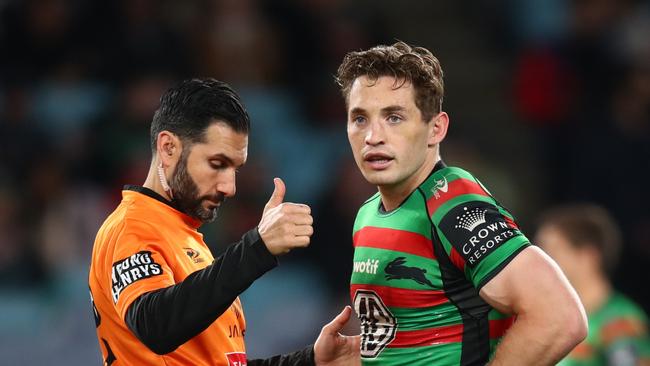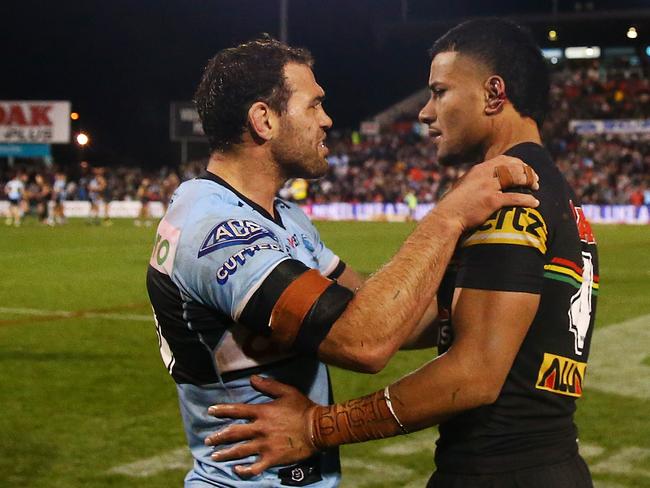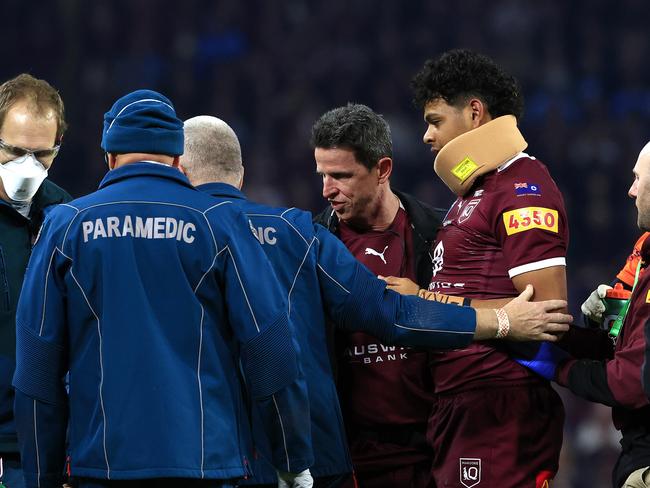NRL’s data proves high-shot crackdown is reducing rate of HIA incidents
The NRL claims that recently released data proves that rugby league is safer thanks to the high-shot crackdown implemented at and since Magic Round in 2020.

NRL
Don't miss out on the headlines from NRL. Followed categories will be added to My News.
This is proof the NRL is winning the war on high shots and sickening concussions in rugby league.
ARL Commission boss Peter V’landys has declared the code’s crackdown on high tackles is working following revelations there has been a drastic 42 per cent decrease in players ruled out of NRL games due to concussions.
Official NRL data, exclusively obtained by News Corp, shows the infamous Magic Round high-shot crackdown of 2020 has cleaned up the game, triggered more intense medical scrutiny and made it safer for the sport’s top athletes.
The NRL has been rocked in recent weeks by a spate of worrying collisions involving some of the code’s best players.
Cameron Murray, Selwyn Cobbo and Lindsay Collins suffered head knocks in the Origin decider.
Stream every game of every round of the 2022 NRL Telstra Premiership Season Live & Ad-Break Free During Play on Kayo. New to Kayo? Start your free trial now >

Penrith ace Stephen Crichton underwent ear surgery after an accidental head clash with Dale Finucane, who was controversially suspended for two games, while Queensland Origin star Kalyn Ponga is out indefinitely after his third concussion in six weeks against the Roosters last Friday week.
Adding to the carnage, Maroons prop Collins was knocked out again playing for the Roosters in Thursday night’s 20-10 defeat of Manly.
But amid the spate of head-trauma incidents, V’landys dismissed fears the NRL is becoming more dangerous than ever, with two years of statistical analysis showing rugby league at the top level is witnessing fewer concussive episodes.
“Our numbers show that the high-shot crackdown has had a massive effect on a reduction in HIAs (Head Injury Assessments),” V’landys said.
“We don’t want thugs in the game.

“The majority of fans have agreed with our crackdown (on high tackles). Our data shows 70 to 80 per cent of fans are supportive of the crackdown and that’s from a survey of more than 20,000, not the army of self-appointed critics on Twitter.
“We copped a lot of criticism but as chairman I was always determined to protect the welfare of our players and our approach is working.”
According to NRL data, the number of ‘HIA events’, in which a player leaves the field to be examined for a possible match-ending head knock, has dropped from 234 after 19 rounds last season to 192 at the corresponding stage this year _ a decrease of 18 per cent.
Last season, after 19 rounds, 105 players were ruled out of NRL matches after failing HIAs. This season, entering round 20, that figure is 61, a decrease of 42 per cent.
The number of head-trauma incidents flagged to the NRL’s respective club doctors has dropped from 646 last year to 536 this year, a reduction of 17 per cent.
In perhaps the most promising statistic, the number of players charged by the NRL match-review committee for high shots has plummeted from 75 last year to 25 this season, a stunning drop of 67 per cent.
“We are very pleased with the data. This is proof our crackdown has worked and is working,” V’landys said.
“I was prepared to lead the way on this and I didn’t care about the criticism because I knew the end result was going to be worth it.
“I did it for the players. I want all our NRL players to have a happy, healthy life after football.
“I don’t want them to have brain damage and be looking at the stars, I want them to have a quality of life with their kids, partners and family.
“There are fewer penalties (for high shots). Everything around the head has improved in terms of tackling technique and the players have adjusted.
“It will never be perfect, of course, but our crackdown has made sure the players have got the message.

“This is good for their future life prospects. No matter what anyone says, hitting someone in the head was never in the rules of the games.
“It’s the forceful ones we wanted to get rid of. There’s been a knock-on effect, no doubt about that.
“Sometimes you have to go hard to get results and we are getting results.
“If it means there are less concussions and our players can enjoy a healthy life long after they have retired, then we have done our jobs as administrators of the game.
“We have done the right thing and the game is better for it.”
In a bid to beef-up their fight for player safety, the NRL this season introduced an independent doctor to the Bunker, using video technology to make decisions, remotely, on whether a player who suffers a head knock should be removed from the game for a HIA check.
The NRL has come under fire for the move, with critics arguing an independent doctor watching off-site footage cannot make an accurate assessment of a concussed player, but the extra layer of vigilance appears to be helping.
The number of incidents reviewed by the Injury Surveillance Bunker has steadily increased from 1288 in 2020 (after 19 rounds), 1496 last season and 1503 this year.
Despite more incidents being reviewed, there has been a decrease in HIA events and a major drop in players being ruled out of games for concussions.

Notably, just 12 per cent of concussions so far this season have occurred from incidents of foul play leading to a penalty, sin bin or send off.
NRL chief executive Andrew Abdo welcomed the data and backed the introduction of the Bunker’s independent doctor.
“The numbers are really pleasing because this (head-trauma issues) is a really important area for us,” Abdo said.
“We have more sets of eyes, we have more scrutiny on potential head knocks but, importantly, we are seeing slightly less of those (head knocks) and, pleasingly, a lot of players returning to play.
“Essentially, we have an extra set of eyes (with the Bunker doctor).
“Instead of having just club doctors on the sideline having to deal with multiple injuries and multiple players on the sideline, we have the ability for an additional doctor to view incidents using replays and different camera angles.
“There has definitely been an adjustment to tackling techniques.
“All we are concerned about is: is there a potential HIA needed, are we getting it done quickly and are we removing the player from a potentially dangerous situation and getting them assessed?
“It’s all about trying to use technology to advance player welfare during a pretty tough 80 minutes.
“The progress we have made this year is good news.”
More Coverage
Originally published as NRL’s data proves high-shot crackdown is reducing rate of HIA incidents





